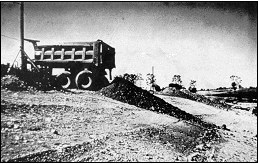 |
 |
To Print Use The pdf File
ILLINOIS URBAN MANUAL
PRACTICE STANDARD
TOPSOILING
(acre or sq ft)
CODE 981
 (Source: VA Erosion and Sediment Control Handbook) |
DEFINITION
Methods of preserving and using topsoil to enhance final site stabilization with vegetation.
PURPOSE
The purpose of this practice is to provide a suitable growth medium for final site stabilization with vegetation.
CONDITIONS WHERE PRACTICE APPLIES
a. The texture, bulk density, pH, or nutrient balance of the available soil cannot be modified by a reasonable means to provide an adequate growth medium for the desired vegetation.
b. The soil is too shallow to provide adequate rooting depth or will not supply necessary moisture and nutrients for growth of desired vegetation.
c. The soil contains substances toxic or potentially toxic to the desired vegetation.
CRITERIA
Determine if sufficient quantities of suitable topsoil as described in material specification 804 Material for Topsoiling is available at the site or nearby. Topsoil shall be spread at a lightly compacted depth of 2 to 4 inches. Depths of 4 inches or greater are recommended where fine-textured (clayey) subsoil or other root limiting factors are present.
If topsoil is to be stockpiled at the site, select a location so that it will not erode, block drainage, or interfere with work on the site.
During construction of the project, soil stockpiles shall be stabilized or protected with sediment trapping measures such as practice standards SILT FENCE 920 or TEMPORARY SEEDING 965. Perimeter controls shall be placed around the stockpile immediately; seeding of stockpiles shall be completed within 7 days of formation of the stockpile if it is to remain dormant for longer than 30 days.
Bonding - If the topsoil and existing soil surface are not properly bonded water will not infiltrate evenly, and it will be difficult to establish vegetation.
Care must be taken not to apply topsoil to an existing soil surface if the two have contrasting textures. Clayey topsoil over sandy subsoil is a particularly poor combination, as water creeps along the junction between the two soil layers and may cause the topsoil to slough.
Do not apply topsoil to slopes greater than 2:1 to avoid slippage. Topsoiling of steep slopes should be discouraged unless good bonding of the soils can be achieved.
Depending on subsoil conditions, additional measures may be required for ornamental shrub and tree plantings. See practice standard TREE AND SHRUB PLANTING 985.
CONSIDERATIONS
Topsoil is the surface layer of the soil profile, generally characterized as darker than the subsoil due to the enrichment with organic matter. It is the major zone of root development and biological activity. Microorganisms that enhance plant growth thrive in this layer. Topsoil can usually be differentiated from subsoil by texture as well as color. Clay content usually increases in the subsoil. Where subsoils are high in clay, the topsoil layer may be significantly coarser in texture. The depth of natural topsoil may be quite variable. On severely eroded sites it may be gone entirely.
Advantages of topsoil include its higher organic matter content, friable consistence (soil aggregates can be easily crushed with only moderate pressure), its available water holding capacity, and its nutrient content. Most often it is superior to subsoil in these characteristics. The texture and friability of topsoil are usually much more conducive to seedling germination, emergence, and root growth.
In addition to being a better growth medium, topsoil is often less erodible than subsoil, and the coarser texture of topsoil increases infiltration capacity and reduces runoff.
Although topsoil may provide an improved growth medium, there may be disadvantages, too. Stripping, stockpiling, hauling, and spreading topsoil or importing topsoil may not be cost-effective. Handling may be difficult if large amounts of branches or rocks are present or if the terrain is too rough. Most topsoil contains weed seeds, which compete with desirable species.
In site planning, compare the options of topsoiling with preparing a seedbed in the available subsoil. The clay content of many subsoils retains moisture. When properly limed and fertilized, subsoil may provide a satisfactory growth medium, which is generally free of weed seeds.
Topsoiling is normally recommended where ornamental plants or high-maintenance turf will be grown. It may also be required to establish vegetation on shallow soils; soils containing potentially toxic materials, stony soils, and soils of critically low pH (highly acid).
PLANS AND SPECIFICATIONS
The plans and specifications for installing topsoiling shall be in keeping with this standard and shall describe the requirements for applying the practice to achieve its intended purpose. At a minimum include the following items:
All plans shall include the installation, inspection, and maintenance schedules with the responsible party identified.
The application of topsoil shall meet the requirements as listed in the construction specification 752 STRIPPING, STOCKPILING SITE PREPARATION AND SPREADING TOPSOIL.
OPERATION AND MAINTENANCE
After topsoil application, follow procedures for seedbed preparation. Take care to avoid excessive mixing of topsoil into the subsoil. Permanently stabilize the site following appropriate practice standards as quickly as practicable. Periodically inspect the site until permanent stabilization is achieved. Make necessary repairs to eroded areas or areas of light vegetative cover.
NRCS IL February 1994